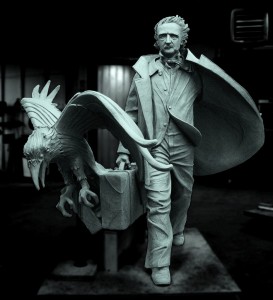Bloodthirsty Poe fans pic.twitter.com/1VuvT1FSIM — Nick DeLuca (@NickDeLuca1) October 5, 2014
On Friday, October, 5, the highly-anticipated statue of Boston native Edgar Allan Poewas unveiled to the public. Poe, born in Boston in 1809, will have been deceased for 165 years on Tuesday, October 7, so the life-sized likeness comes just in time to celebrate all of the prolific author an poet’s achievements and contributions to American literature.

A charged crowd gathered at Edgar Allan Poe Square, the corner of Boylston Street and Charles Street South, full of Bostonians, historians, curious passersby, Poe disciples, and more to see Stefanie Rocknack’s masterpiece Poe Returning to Boston. After so many years, the relationship Poe famously and contentiously had with Boston and its literary pundits is long dissolved and now, with respect to history, those who read his his work are almost always beholden to its greatness.
“Poe fans, going bask as far as Thomas Wentworth Higginson and Julia Ward Howe, she of The Battle Hymn of the Republic, are smiling down on you from whatever after-life Frog Pondians enjoy,” joked Paul Lewis, a professor of literature at Boston College, and chairman and founder of the Edgar Allan Poe Foundation.
A rendition of Poe’s poem “Eldorado” was recited and a few remarks were made by former United States poet laureate Robert Pinsky as well as Mayor Marty Walsh’s top speechwriter before the black blanket was removed from the statue. The hoard of onlookers then tried to maneuver its way as close to Poe as possible, hoping to snap a photo or a selfie with the writer, known primarily for his residence in Baltimore, now immortalized in the heart of Boston.
Poe fan pic.twitter.com/OiLIo6eI0a — Nick DeLuca (@NickDeLuca1) October 5, 2014
The statue will be a staple in the recently launched Literary Cultural District, an ambiguous area comprised of historically significant structures and locations linked together by their connection to Boston’s deep literary past. Separate efforts have been made to install a bust of Edgar Allan Poe within the hallowed halls of the Boston Public Library

